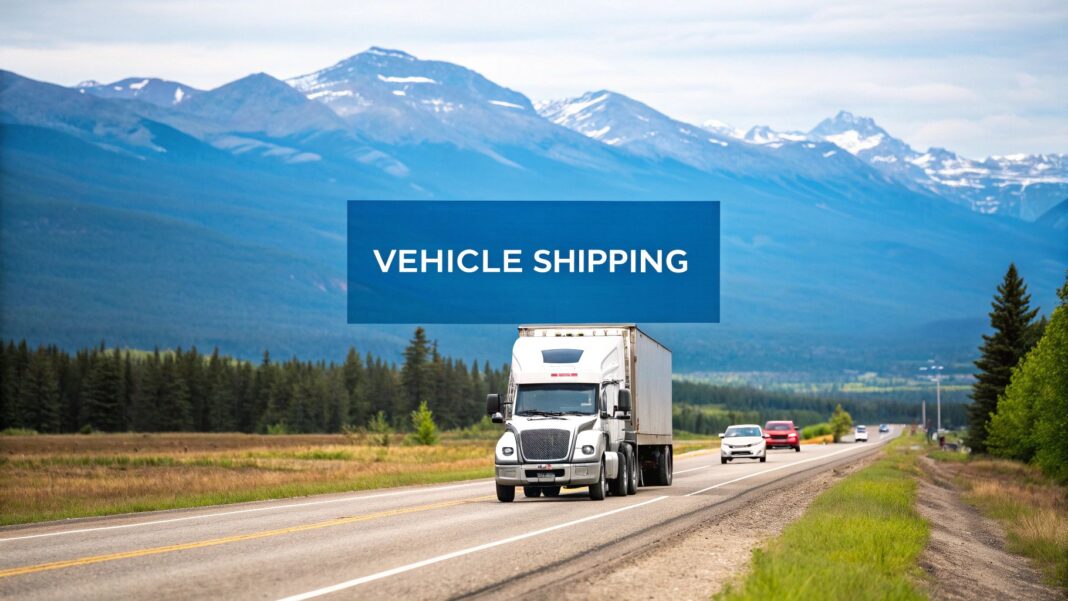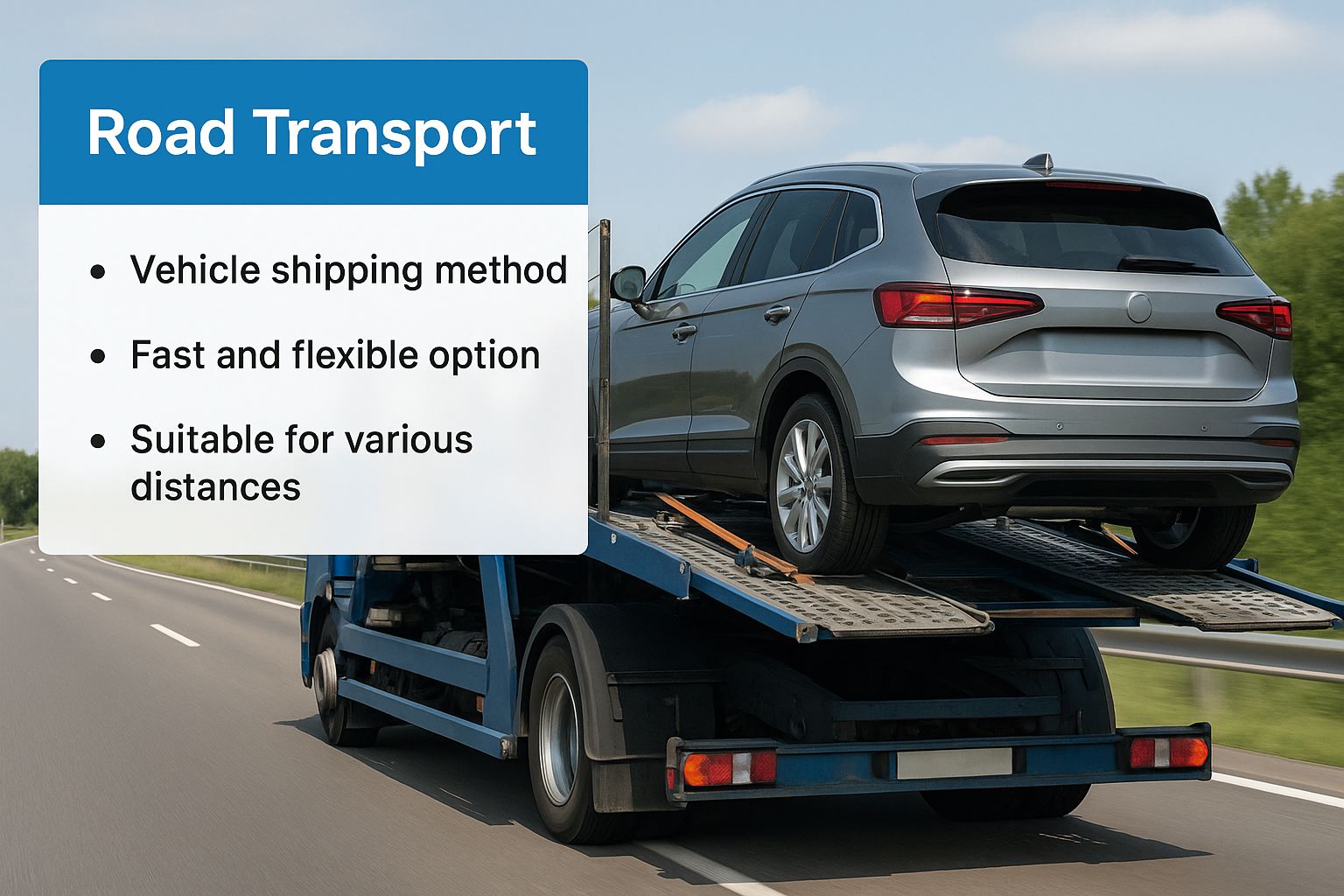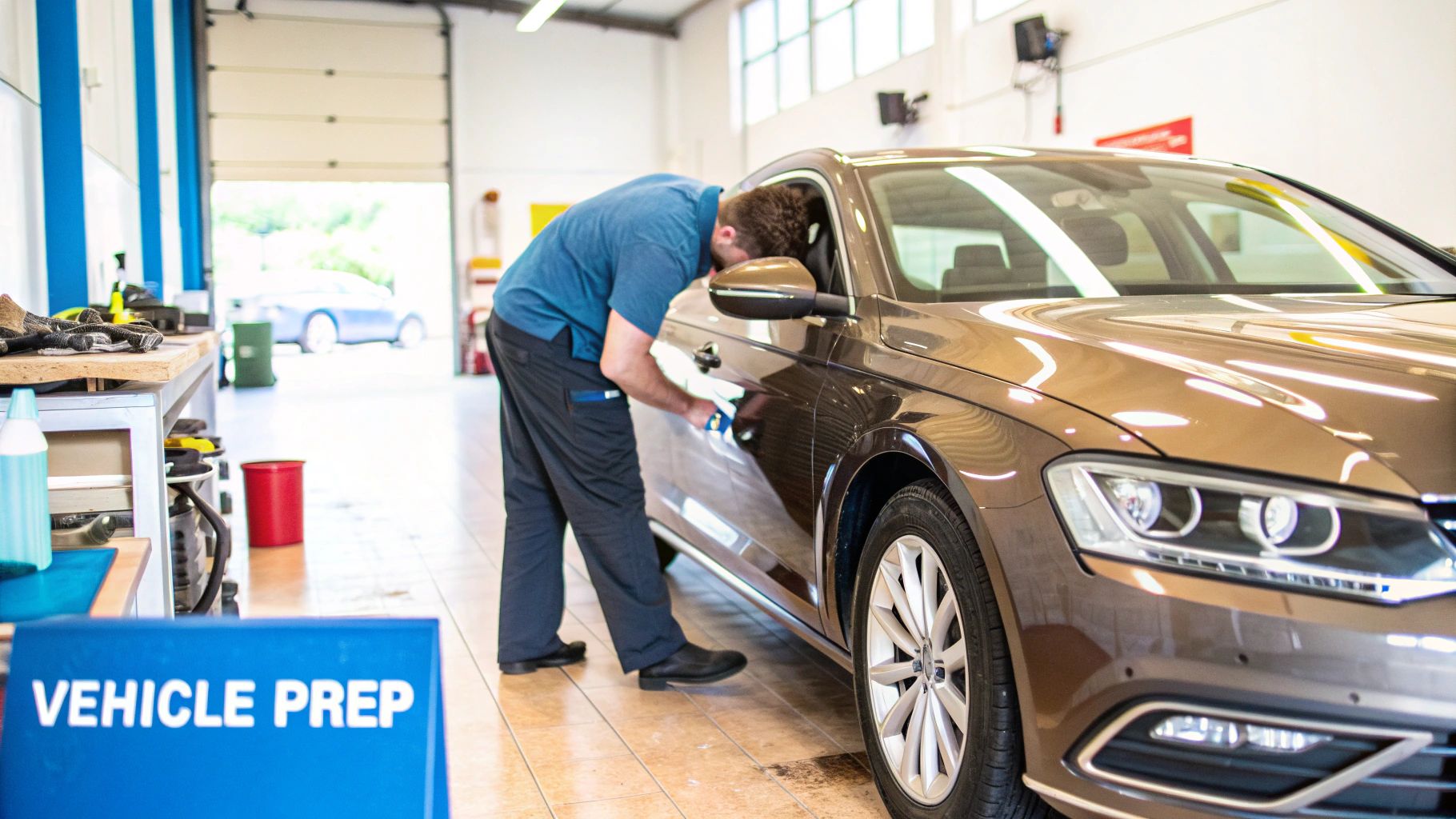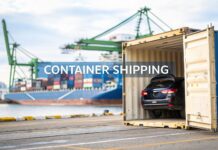
Shipping a car across Canada is a major logistical step, but it boils down to a few key decisions. Understanding your options upfront directly impacts the final cost, timeline, and level of protection your vehicle receives during its journey.
This guide provides the actionable information you need to navigate the process, from choosing a transport method to preparing your vehicle for a successful, damage-free trip.
Understanding Your Vehicle Shipping Options in Canada
Whether you're relocating for work or sending a car to a family member, the process begins with one fundamental choice: open or enclosed transport. This decision is the primary driver of your shipping quote.
Think of it as the difference between economy and first-class air travel. Both will get your vehicle to its destination, but the experience and protection level vary significantly. For most standard vehicles, open carriers are the industry norm, offering a balance of safety and cost-effectiveness by transporting multiple cars at once.
Open vs. Enclosed Transport: Making the Right Call
This is the first decision you'll make, and it should be based on your vehicle's value, your budget, and your tolerance for risk.
Open Carrier Transport: This is the most common method you see on the Trans-Canada Highway—vehicles secured on a double-decker trailer. It is the industry standard because it's safe, efficient, and the most affordable option. For shipping a standard sedan, SUV, or truck from Toronto to Calgary, open transport is the most practical choice. The vehicle is exposed to the elements, just as it would be if you were driving it yourself.
Enclosed Carrier Transport: This method provides a fully protected environment for your vehicle inside a covered trailer. It shields your car from weather, road debris, rock chips, and dust. This is the recommended service for classic cars, luxury vehicles, race cars, or any vehicle where maintaining showroom condition is a top priority.
Actionable Insight: While open transport is perfectly safe for over 95% of vehicle shipments, enclosed transport provides complete protection and peace of mind. Consider it a necessary insurance policy for high-value or sentimental vehicles, guaranteeing they arrive in pristine condition.
Key Factors That Influence Your Quote
After choosing your carrier type, several other variables will determine your final price. Understanding these factors will help you budget accurately and avoid unexpected costs.
The most significant factor is distance. A cross-country shipment from Halifax to Vancouver will naturally cost more than a regional move, like from Montreal to Quebec City, due to fuel, labour, and time.
Your vehicle's size and weight are also critical. A large pickup truck or a full-size SUV occupies more space and adds more weight to the trailer than a compact car, resulting in a higher shipping fee.
Finally, seasonality plays a role. Shipping during the winter months, especially across challenging routes like the Rocky Mountains, can increase costs. Adverse weather can cause delays and road closures, and there is often higher demand for fewer available carrier spots during these periods.
How to Choose the Right Vehicle Transport Service
Selecting a reliable company for shipping vehicles within canada is the most critical decision in this process. Resisting the temptation to choose the lowest quote is essential, as an unusually cheap price can often lead to delays, poor communication, and inadequate insurance. True value comes from a trustworthy partner committed to protecting your vehicle from pickup to delivery.
This requires due diligence beyond simply comparing prices. You must verify insurance coverage, read customer reviews, and understand whether you are dealing with a direct carrier or a broker.
Vetting Potential Transport Companies
Before signing any contract, conduct thorough research. A reputable company will be transparent and have a verifiable track record. Start by reading online reviews, paying close attention to how the company resolves issues or handles unexpected delays. A company's response to problems reveals its true level of customer service.
Next, request a copy of their certificate of insurance. A legitimate carrier will provide this document without hesitation. This certificate is proof that they carry sufficient cargo insurance to cover your vehicle's value in case of an incident during transit. If a company is reluctant to share this, consider it a major red flag.
Actionable Insight: A quote that seems too good to be true usually is. An unusually low price may indicate insufficient insurance, hidden fees, or unreliable service. Dependable vehicle transport is an investment in security and peace of mind, not just a race to the bottom on price.
This infographic provides a visual breakdown of how vehicles are professionally loaded and secured for transit, which is the core of the vehicle shipping process.

As shown, each vehicle is meticulously fastened to ensure it remains stationary throughout the journey, arriving in the same condition it was picked up in.
Carrier vs Broker What Is the Difference
During your search, you will encounter two primary types of service providers: direct carriers and transport brokers. Understanding their roles is crucial for choosing the right service for your needs.
A direct carrier owns and operates its own trucks. A broker, on the other hand, is a logistics specialist who coordinates shipments using a network of pre-vetted carriers. Each offers distinct advantages.
Here is a practical breakdown to guide your decision.
Comparing Vehicle Transport Carrier Options
| Factor | Independent Carrier | Transport Broker |
|---|---|---|
| Communication | Direct contact with the driver/company. | A single point of contact who manages all carrier logistics. |
| Flexibility | Limited to their own fleet, routes, and schedules. | Access to a vast network, providing more shipping options and faster pickup times. |
| Pricing | May offer lower prices by eliminating the middleman. | Can leverage their network to find competitive rates and fill empty spots on trucks. |
| Vetting | You are responsible for verifying their insurance and operating authority. | They pre-vet all carriers in their network, ensuring they are licensed and insured. |
There is no universally "best" option; the right choice depends on your priorities. Brokers are particularly valuable for tight deadlines or shipments to remote areas, as their extensive networks can locate available trucks more efficiently. Conversely, some customers prefer the direct communication offered by a carrier.
The North American trucking industry is a vital economic engine. In March 2025, trucks moved freight valued at $67.5 billion across the Canada-U.S. border alone. This massive volume underscores the importance of both carriers and brokers in the logistics chain.
A company that offers a combination of brokerage and direct car transport services can provide the flexibility needed for a smooth shipment. The ultimate goal is to find a transparent, fully insured provider with a proven track record of customer satisfaction.
Getting Your Vehicle Ready for Transport
Proper preparation is key to a smooth and damage-free transport experience. Taking a few practical steps before the carrier arrives will safeguard your vehicle and ensure a clean inspection process. This involves more than a simple cleaning; it’s about preparing your car for a secure journey.
First, wash your vehicle thoroughly. While it may seem counterintuitive to wash a car that will be on the road, a clean exterior allows you and the driver to accurately inspect and document its pre-existing condition. Every scratch, ding, and scuff can be clearly seen and noted on the Bill of Lading.
Document Everything Before Pickup
Once the car is clean, use your smartphone to create a detailed visual record. Take clear, well-lit photos and a short video of the entire vehicle from all angles. Zoom in on any existing damage, no matter how minor.
This documentation serves as your baseline proof of the vehicle's condition before it was handed over to the carrier. In the rare event of a dispute at delivery, these timestamped images are invaluable.
Actionable Insight: Treat this documentation as your personal insurance policy. Clear "before" photos can quickly resolve any disagreements about when damage may have occurred, ensuring a smooth and professional handover at both ends of the journey.
Next, prepare the interior and mechanical components. These steps are not mere suggestions; they are standard safety and liability requirements for most carriers.
Fuel Level: Reduce the fuel level to approximately one-quarter of a tank. This is sufficient for loading and unloading but reduces the vehicle's overall weight, which is crucial for the transport truck's weight compliance.
Personal Belongings: Remove all personal items from the vehicle. Carrier insurance does not cover personal belongings left inside. Electronics, clothing, and other valuables are shipped at your own risk. Removing them also prevents items from shifting and potentially causing damage during transit.
Secure Loose Parts: Perform a final walk-around to secure any exterior parts. Retract antennas, fold in side mirrors if possible, and ensure custom spoilers or roof racks are firmly attached. If you have a convertible, make sure the top is securely latched to protect the interior from the elements.
These preparation steps streamline the entire process, protect your vehicle, and facilitate a quick, professional handover with the driver. A well-prepped car is essential for a secure shipment.
Breaking Down the Costs and Paperwork
Understanding the components of your shipping quote and the purpose of the required paperwork will empower you to make informed decisions. The final price is influenced by several factors, and each document serves to protect both you and the transport company.

Your primary cost determinant is the choice between an open and enclosed carrier. Open carriers are the more economical option as they transport multiple vehicles simultaneously. For classic, luxury, or high-value cars, the higher cost of an enclosed carrier is a worthwhile investment for the complete protection it provides against weather and road debris.
The shipping route is another major cost factor. High-traffic routes, such as Toronto to Vancouver, often have more competitive pricing due to the volume of carriers. Shipping to or from a remote location will typically cost more. Seasonality also affects price; shipping through mountainous regions in winter is more challenging and therefore more expensive than in the summer.
The Bill of Lading Is Your Best Friend
The single most important document in the entire process is the Bill of Lading (BOL). It is much more than a receipt; it is the legal contract between you and the carrier. The BOL details the terms of service, pickup and delivery locations, and, most crucially, serves as a condition report for your vehicle.
During pickup, you and the driver will inspect the vehicle together and note every existing scratch, dent, or imperfection on the BOL. This process is repeated at delivery. It is vital that you take your time during this inspection and agree with all notations before signing. Your signature legally confirms the vehicle's condition at that point in time.
Actionable Insight: Never rush the vehicle inspection. The BOL is your primary evidence should you need to file a damage claim. A thorough and accurate inspection at both pickup and delivery is the best way to protect your investment and prevent disputes.
Vehicle transport is a cornerstone of the Canadian economy. The transportation and warehousing sector contributed $96.5 billion to the national GDP, with trucks moving 46% of Canada's international trade goods by value. This robust infrastructure supports the high demand for services like shipping vehicles within canada.
Making Sense of Insurance Coverage
Every reputable car shipping company is required to carry cargo insurance. This policy covers damage to your vehicle resulting from carrier negligence during transit. However, this insurance has limitations. It typically does not cover damage from "acts of God" (like hailstorms) or any personal items left inside the car.
Therefore, it is essential to review your personal auto insurance policy. Contact your insurance agent to understand what coverage, if any, your policy provides while your vehicle is being transported by a third party. To learn more, research your car insurance options.
If there are gaps between the carrier's insurance and your own, or if you are shipping a high-value vehicle, consider purchasing supplemental insurance. Always ask the transport company for a copy of their insurance certificate to verify their coverage limits and deductibles, ensuring you are fully protected throughout the shipping process.
What to Expect During Pickup and Delivery
Knowing the step-by-step process for pickup and delivery will help you manage expectations and ensure a smooth handover. While the procedure is straightforward, your active participation is crucial for proper documentation and a stress-free experience.

Upon arrival, the carrier will park their large rig in a safe and legal location, which may be down the street rather than directly in front of your home. The driver will then initiate the official vehicle inspection using the Bill of Lading (BOL).
The Critical Pickup Inspection
This is your moment to be diligent. You and the driver will conduct a joint walk-around of your vehicle, and the driver will mark any pre-existing damage on the BOL's vehicle diagram. Speak up and point out anything you see, ensuring it is documented before you sign.
This is the time to reference the photos you took during your preparation. By signing the BOL, you are agreeing to the documented condition of your vehicle at pickup. Taking a few extra minutes here can prevent potential issues later.
Actionable Insight: The pickup inspection is the most important step in the shipping process. A meticulously documented BOL protects both you and the carrier, forming the factual basis for the final inspection at delivery and preventing nearly all potential disputes.
Once the inspection is complete and the BOL is signed by both parties, the driver will professionally load your vehicle onto the transport truck, securing it with heavy-duty straps to prevent any movement during transit.
Staying Informed and Managing Delivery
After your vehicle is en route, the transport company will typically provide a tracking number or the driver's direct contact information. While it's acceptable to request updates, remember that drivers cannot answer calls while operating the vehicle. A text message is often the most effective way to request an ETA.
At the destination, the process is reversed. The driver will carefully unload your vehicle, and you will conduct a final inspection, comparing its current condition to the notes on the original BOL. If you selected door to door auto transport, this final check will conveniently take place at your specified address.
In the rare event that you find new, undocumented damage, point it out to the driver immediately. It is crucial to note the damage directly on the Bill of Lading before signing it. This notation is the necessary first step to initiate an insurance claim. Follow up by taking clear photos of the damage from multiple angles. A careful delivery inspection is the final step to ensuring a successful and worry-free vehicle shipment.
A Few Common Questions We Hear
Even with a solid plan, questions are natural. Here are clear, practical answers to some of the most common queries about shipping a vehicle in Canada.
How Long Will It Take to Ship My Car in Canada?
The transit time is determined almost entirely by the distance of the shipment.
For a cross-country route, such as Toronto to Vancouver, you should plan for a transit time of 7 to 14 days. For shorter, regional transports like Calgary to Edmonton, the timeline is much quicker, typically 1 to 3 days.
The carrier will provide a delivery window. Be aware that factors like weather, road construction, and mandatory driver rest periods can occasionally cause minor delays.
Can I Pack My Car With Personal Stuff?
While it may seem like an efficient way to move belongings, carriers are not licensed to transport household goods. Their cargo insurance covers the vehicle only, not its contents.
Any personal items left in the car are not insured against loss or damage. Some drivers may permit a single box or suitcase in the trunk (generally under 100 lbs), but this must be explicitly approved by the transport company beforehand.
The most practical and safest approach is to empty your vehicle completely. The risk of loss or damage is not worth it.
Is My Vehicle Covered by Insurance During Transit?
Yes. All legitimate and professional vehicle transport companies carry cargo insurance. This policy is designed to cover damage to your vehicle that occurs due to carrier negligence during transit.
Actionable Insight: Before booking, always request a copy of the company's certificate of insurance. This document details their coverage limits and any applicable deductibles, giving you a clear understanding of your vehicle's protection.
The North American trucking network is a robust system. Cross-border traffic between Canada and the U.S. has reached record levels, with nearly two-thirds of all Canadian truck loads recently destined for the U.S. This high volume demonstrates the system's capacity but also means factors like driver availability can influence scheduling. You can learn more about these Canadian market trends to understand the logistics landscape.
What’s a Bill of Lading, and Why Does It Matter So Much?
The Bill of Lading (BOL) is the most critical document in the shipping process. It functions as three key documents in one:
- Your contract with the carrier, outlining the terms of service.
- Your official receipt, confirming the carrier has taken possession of your vehicle.
- The official inspection report, detailing the vehicle's condition at pickup and delivery.
At both pickup and delivery, you and the driver will inspect the vehicle and sign the BOL to confirm its condition. This document is your essential proof if you need to file a damage claim. A properly completed BOL ensures transparency and protects all parties involved.
When you need a reliable partner for shipping vehicles within Canada, the experts at We Will Transport It are ready to manage all the logistics. We ensure your vehicle arrives safely and on schedule. Get a free, no-obligation quote and let our team handle the details. Find out more at https://www.wewilltransportit.com.





